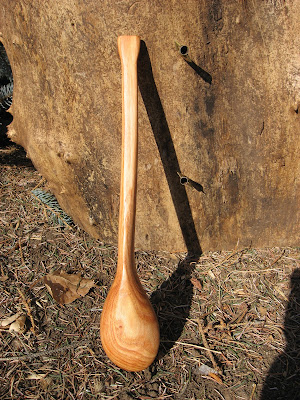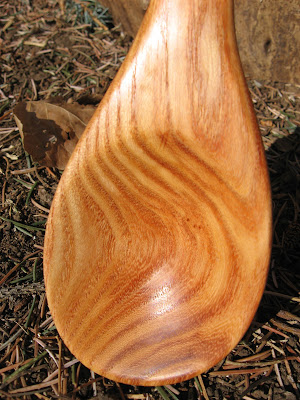Here's a set of spoons carved from foraged Sumac wood-
 |
| sumac spoons |
This is really a nice looking wood, with brilliant golden hues just after burnishing and oiling, then mellowing into a darker copper color after prolonged use.
If you've ever smelled or tasted Sumac berries, you know how yummy and citrusy they smell- well, carving green sumac wood smells like that. It's pretty soft and light wood, though not quite as light as apen, It's quite pleasing to work with.
Here's some close ups.
Th' first one is my everyday spoon. I eat breakfast with it everymorning and any other meal that requires a spoon.
 |
| close up of sumac spoon |
Here's a close up of a smaller stirring spoon.
 |
| carved tip |
I've got enough wood for about twenty more of these. If you'd like one (or more), just let me know. They'll sell for $15 a piece, and will be made to order, as all th' ones in th' pictures above are ours or sold already.
I've also been making some larger Honey Locust spoons like th' ones below, these are cooking spoons, but i can make them any size. This wood is really dense, and hard to work, but looks real nice when finished. A large spoon of this will sell for $30-$50, and eating sized ones for around $20.
 |
| Honey Locust spoon (large) |
 |
| back of same spoon |
 |
| close up of back |
 |
| close up of bowl |
And here's one with a leather hanger
If you want to read about ways to make sumac-ade, a lovely summer drink, see our foraging blog here! Enjoy!
~Rico






What diameter tree did you use for the Sumac spoons? The ones around here are at most 2-3 inches in diameter. I'm going to try a baby spoon out of some tomorrow.
ReplyDeleteHi Joseph, th' sumac trunks were about 4-6 inches diameter... pretty large for a sumac, they came down in an early fall snowstorm, it's very pretty wood, but likes to chip and is extremely light and brittle when dry, i've avoided it for spoons since these ones, but have used it for other things... happy carving. ~rico
DeleteI thought Sumac was poisonous and not to used for human use.
ReplyDeletehmmm, maybe that's why my mouth itches everytime i use these spoons?
DeleteThere are many different types of sumac. Staghorn sumac (Rhus typhina) has an upright flower spike that turns red. Poison sumac have loose clustered hanging berries that are white.
Deletepoison sumac has white berries and is poisonous. Staghorn sumac has red berries and is not poisonous.
ReplyDelete